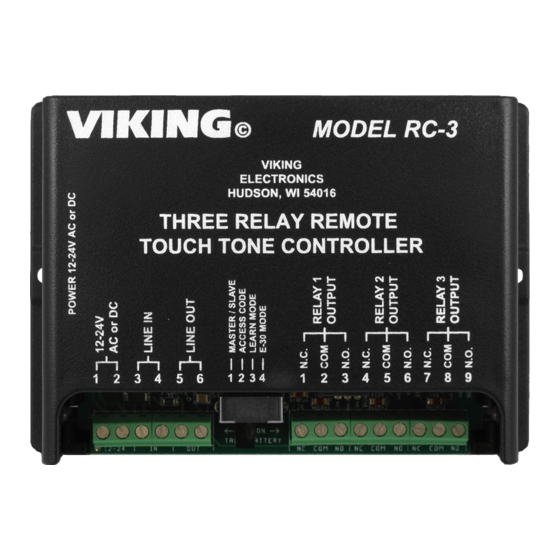
Viking RC-3 Technical Practice
3 relay remote touch tone controller
Hide thumbs
Also See for RC-3:
- Technical practice (9 pages) ,
- Buyer's manual (16 pages) ,
- Application note (1 page)
Advertisement
Quick Links
Download this manual
See also:
Technical Practice
TECHNICAL
TECHNICAL
T
T
E
L
E
E
L
E
The RC-3 also features a built in pulse dialer activated by a contact closure from an
alarm system, temperature sensor, etc. The RC-3 will dial the number up to three times
sending alert tones indicating an emergency.
P
h
o
P
h
o
F
e
a
t
u
r
e
s
F
e
a
t
u
r
e
s
• User Touch Tone programmable
• Non-volatile E
2
memory
• 12 digit alarm activated pulse dialer
• 6 digit security code (to access programming)
• 6 digit access code (disable or enable for
additional control security)
• Switchable 12V talk battery
• Relay interrogation tones
• Programmable relay time delays
• Cascade up to three RC-3's to control up to
nine relays
• Programmable ring delay before answering
• Status LED's for relays 1, 2, 3 and the
answer relay
• One power adaptor can power up to three
units
S
S
C
O
M
O
L
U
T
I
O
N
S
C
O
M
O
L
U
T
I
O
N
S
Control 1 to 9 Relays Remotely
n
e
.
.
.
7
1
5
.
3
8
6
.
8
8
6
n
e
.
.
.
7
1
5
.
3
8
6
.
8
8
6
P
r
a
c
P
r
a
c
2
1
C
2
1
C
F
O
R
T
H
E
S
T
F
O
R
T
H
E
S
T
The RC-3 enables a standard Touch Tone
phone to control up to 3 maintained ON, main-
tained OFF, or momentary relay contacts from
a remote location. The RC-3 is fully user pro-
grammable and uses non-volatile E
Up to three RC-3's can be daisy chained on
the same line to control up to nine relays.
The RC-3 features switchable 12V talk battery
allowing easy installation on the trunk port. In
addition, the unit can be connected directly to
a C.O. line or analog PABX/KSU station.
A
p
p
l
A
p
p
l
1
1
Remote Control of:
• High security building entry systems
• Door strikes and gates in conjunction with
doorboxes (W-1000, etc.)
• Signs, lights, cameras, sprinklers, motors
• Other contact controlled equipment
• Can also be used as an emergency dialer for
alarm systems, etc.
h
t
t
h
t
t
S
p
e
c
S
p
e
c
Power: 120V AC/12V DC 500mA UL listed adapter provided
Shipping Weight: 3.6 kg (8 lbs)
Dimensions: 133mm x 89mm x 44mm (5.25" x 3.5" x 1.75")
Environmental: 0°C to 32°C (32°F to 90°F) with 5% to 95%
non-condensing humidity
Pulse Dialing Speed: 10 pps
Talk Battery Output: 12V DC minimum (15V nominal)
Relay contact ratings: .5A @ 125V AC/1A @ 30V DC
On hook time between alarm dialing: 2.5 seconds
Connections: (2) RJ11 jacks, 10 position screw terminal strip
3 Relay Remote Touch
t
i
c
e
t
i
c
e
Tone Controller
E
N
T
U
R
Y
E
N
T
U
R
Y
i
c
a
t
i
o
n
s
i
c
a
t
i
o
n
s
i
n
f
o
@
v
i
k
i
n
g
e
l
i
n
f
o
@
v
i
k
i
n
g
e
l
p
:
/
/
w
w
w
.
v
i
k
i
n
g
e
l
p
:
/
/
w
w
w
.
v
i
k
i
n
g
e
l
i
f
i
c
a
t
i
o
n
s
i
f
i
c
a
t
i
o
n
s
RC-3
RC-3
May 26, 2005
memory.
2
e
c
t
r
o
n
i
c
s
.
c
o
m
e
c
t
r
o
n
i
c
s
.
c
o
m
e
c
t
r
o
n
i
c
s
.
c
o
m
e
c
t
r
o
n
i
c
s
.
c
o
m
Advertisement

Summary of Contents for Viking RC-3
- Page 1 TECHNICAL Control 1 to 9 Relays Remotely The RC-3 also features a built in pulse dialer activated by a contact closure from an alarm system, temperature sensor, etc. The RC-3 will dial the number up to three times sending alert tones indicating an emergency.
- Page 2 B. Expanding To Control From 4 to 9 Relays Two or three RC-3’s can be daisy chained to the same line to control 1 to 9 relays. One “master” RC-3 can power up to two “slave” RC-3’s by daisy chaining power from terminals 9 and 10. The master/slave shunt should be removed from each slave unit.
- Page 3 A. Immediate Access Mode Go off hook on the C.O. line or access the trunk port of your phone system that the RC-3 is connected to. With the Access Code disabled you can now immediately enter the Touch Tone commands for controlling the RC-3’s relay out- puts (see Operation, section C below).
- Page 4 Due to the dynamic nature of the product design, the information contained in this document is subject to change without notice. Viking Electronics, and its affiliates and/or subsidiaries assume no responsibility for errors and omissions contained in this information. Revisions of this document or new editions of it may be issued to incorporate such changes.















Need help?
Do you have a question about the RC-3 and is the answer not in the manual?
Questions and answers